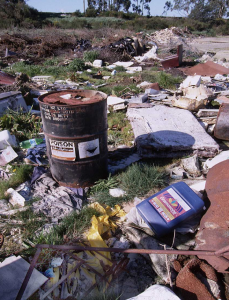History - How Kate Valley became a Landfill
 When the Resource Management Act (RMA) became law in 1991 there were 52 rubbish dumps in Canterbury where communities disposed of unwanted waste. Many of these dumps were in convenient holes in the ground such as former quarries or shingle pits, in riverbeds and above aquifer water supplies. Anyone born before 1980 may remember weekend trips to their local dump to drop off unwanted garden and household rubbish along with hundreds of other families performing the same ritual. As seagulls hovered above and rodents scavenged the piles of rubbish below, the stench of rotting waste made the experience more memorable.
When the Resource Management Act (RMA) became law in 1991 there were 52 rubbish dumps in Canterbury where communities disposed of unwanted waste. Many of these dumps were in convenient holes in the ground such as former quarries or shingle pits, in riverbeds and above aquifer water supplies. Anyone born before 1980 may remember weekend trips to their local dump to drop off unwanted garden and household rubbish along with hundreds of other families performing the same ritual. As seagulls hovered above and rodents scavenged the piles of rubbish below, the stench of rotting waste made the experience more memorable.
New solutions for old rubbish
The RMA brought in new environmental requirements that ultimately forced the closure of these old-style rubbish dumps in Canterbury and the rest of New Zealand. Councils began looking for new sites for environmentally secure and well-engineered landfills to ensure the safe disposal of future waste. By 1995 many of the councils in Canterbury had discovered the cost of providing new high-quality landfills was going to place an enormous burden on their ratepayers. With relatively small waste volumes being produced in some districts the cost of building and operating their own landfill simply wasn’t affordable. However, the RMA meant continuing to use old-style rubbish dumps wasn’t a legal option.
The solution was an innovative partnership bringing together the councils of Canterbury and the waste management expertise of the private sector in a pioneering joint venture. In 1996 Canterbury councils formed a joint committee to plan for managing the region’s waste. The councils recognised that by working as a collective it would be possible to develop a modern well-engineered landfill to the highest international standards to provide affordable and environmentally responsible waste management for the future. This was the first time the Canterbury councils had worked together to solve a region-wide issue.
A public-private partnership
The councils chose two private sector waste companies with recognised landfill experience to join the councils in a joint venture to develop a single landfill for Canterbury in 1999. The joint venture is called Transwaste Canterbury Ltd that owns and operates the Landfill. The joint venture partners have changed since 1999, due to council amalgamations and business acquisitions. The public sector partners in the joint venture are Christchurch City Council and the District Councils of Ashburton, Hurunui, Selwyn and Waimakariri. The private sector partner is Waste Management NZ Ltd, the largest private waste company in New Zealand.
Finding the right location
Transwaste began the search for a suitable location for a regional landfill, with many sites across the region being considered. Kate Valley in the Waipara area of Hurunui District was chosen because of the underlying geology. Beneath the valley is a layer of a low permeable material called Tokama Siltstone that extends down to depths of 200 metres. Low permeability simply means that water can’t soak through the ground. With Kate Valley chosen the land was purchased and the process of securing the necessary resource consents to operate the Landfill began. By March 2004 the resource consents had been issued and construction of the Landfill commenced. Over the next 14 months roads were upgraded or constructed and over 1.5 million cubic metres of soil and rock shifted to create the new Kate Valley Landfill that received the first waste in June 2005 on time and on budget.


